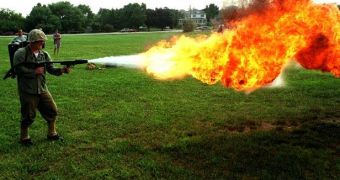The modern flamethrower is a pyrotechnic weapon originating from an idea several thousands of years old, used in modern warfare as a weapon of intimidation, to flush a hideout and to fight off enemy forces. The basic idea behind the concept is to spread fire in a designated area by launching burning fuel from a distance.
Some of the first flamethrower designs appeared and were used in warfare in the 5th century B.C. in the form of long narrow tubes filled up with burning solid fuels that could be thrown at the enemy forces by blowing air through one end of the tubes. Later on, the Byzantine Empire advanced the design by changing the fuel mix from solid to a highly-flammable liquid mixture, which was propelled into a burning fluid stream by pumping it from a large reservoir.
Allegedly, the Chinese copied this design and improved it with a much better pump able to push continuous fluid streams, unlike the Byzantine one which pumped fluid only on the down stroke thus not being able to deliver but short flame bursts. Another Chinese invention, the gunpowder, then completely eclipsed the flamethrower up until the onset of World War II when the Germans reintroduced the latter in the arsenal of modern warfare.
Construction
Typical handheld flamethrowers consist of two tanks, one holding the flammable liquid mix and one for the pressurized gas propelling the flame, a gun housing and an ignition system. Gas from the pressurized tank exerts pressure on the combustible in the other tank and forces it through a hose and into the gun housing. At the same time, part of the gas (usually butane) is redirected to the tip of the gun housing to maintain the flame when the flamethrower is in standby.
The ignition system can vary widely, but the simplest and most used type consists of a high resistance wire brought to incandescence when electric current is pumped through it.
How it works
The flamethrower is brought into standby by opening the ignition valve that delivers butane to the tip of the gun housing and lighting it with the help of the ignition system. This creates a small flame that remains lit as long as it is supplied with gas from the pressurized gas tank.
When the trigger is pushed pressurized fuel from the tank is released by a valve into the fuel hose and into the gun housing, and then ejected into the atmosphere in the form of a burning combustible stream that catches fire from the small flame at the tip of the gun.

 14 DAY TRIAL //
14 DAY TRIAL //